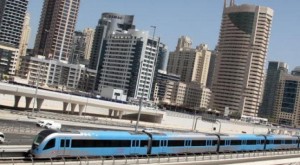By Stephen Jones www.theepochtimes.com
Over a year ago, on the auspicious date 9/9/09, transport officials unveiled the Middle East’s first metro system in Dubai.

The surfaces throughout the entire sky-level network were glittering and gleaming on that opening night, and muzak was piped in through the speakers to a clutch of guests who had won a Willy Wonka-style competition to be the first to ride on the trains.
Back then, officials were so protective of their creation that press photographers were severely curtailed in taking pictures inside the stations.
More than 379 days on, it’s clear that bosses at the Roads and Transport Authority, are doing their best to maintain the image of the opening night. Despite the daily thump of thousands of commuters, a small army of cleaners polish the floors, windows and even the walls throughout the day.
Scores of police stand guard in grass green uniforms and military berets in the two dozen or so stations that have been opened since the launch night. Eating and drinking are strictly prohibited, punishable by a fine of up to Dh500 ($136)—a measure designed to prevent crumbs and sticky chewing gum in the station or on the train.
Littering—including the practice of leaving newspapers on your seats as you exit the train—is also an offense, as is running for a train.
Despite the train stopping at several airport terminals, taking luggage on the train above the size of large hand luggage was also prohibited until recently.
When the metro first started, local media speculated over whether buskers would be allowed on the platforms, but judging by the current restrictions, it is seems highly unlikely in the near-future.
Dubai Metro is a highly sanitized version of the metro systems, which Western expats may know and love (to differing degrees), in London, Paris and New York.
But it is not entirely diminished on that account. It is lauded in the eyes of many for being clean, punctual, modern and safe.
It is also significantly cheaper than those elsewhere. A journey from one end of the city to another can cost just Dh5 ($1.36)— a bargain, considering a comparable journey in London can cost £4.50 ($7.10).
It is primarily for this reason why the metro has become such a hit with the low-income expatriate population—for whom much of the city was once practically off-limits owing to the prohibitively high-cost of the yellow, government-owned taxis.
Dubai stretches out in a thin line along the coastline from the old town of Deira to the luxurious sand-colored apartment blocks of Jumeirah Beach Residence.
The overland railway of the metro, suspended high above the traffic, is like a spinal column for the sprawling metropolis.
Dubai is one of the most progressive cities in the Middle East, yet still retains key elements of its conservative traditions.
In the metro, this manifests itself in a segregated cars for women and children. Although women are free to sit throughout the train, many—including Westerners and East Asian women—choose to sit in the designated cars in order to escape the baleful eyes of laborers from the sub-continent, who have been without female company for years at a stretch.
Sometimes, when I have the afternoon free, I like to take a ride on the metro to nowhere in particular. The huge volume of people from diverse backgrounds who share the car with me is at once baffling and intriguing.
While most people I see are heading somewhere, either to work or to a mall. Every now and then I share a knowing glance with someone, who I realize, is also there solely to watch, and marvel.
















